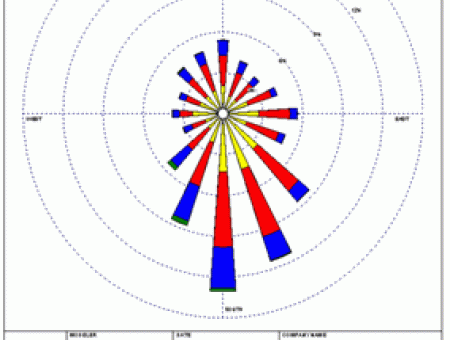Wind Rose Data

Wind Rose Plots for Speed and Direction
A wind rose gives a succinct view of how wind speed and direction are typically distributed at a particular location. Presented in a circular format, the wind rose shows the frequency of winds blowing from particular directions. The length of each "spoke" around the circle is related to the frequency of time that the wind blows from a particular direction. Each concentric circle represents a different frequency, emanating from zero at the center to increasing frequencies at the outer circles.
About the Dataset
The National Water and Climate Center provides a dataset of wind rose plot images in .gif format. The images are organized by state, by city within each state, and then by month. The wind roses are based on hourly data from NOAA's Solar and Meteorological Surface Observation Network (SAMSON) dataset. The period of record is 1961-1990.
The wind roses in this dataset contain additional information, in that each spoke is broken down into discrete frequency categories that show the percentage of time that winds blow from a particular direction and at certain speed ranges. All wind roses shown in the dataset use 16 cardinal directions: north (N), north-northeast (NNE), northeast (NE), etc. The legend at the bottom of the wind rose gives additional information such as the unit (m/sec), the average wind speed for the month over all hours, the percentage of time that the winds are calm, and the years, months, and hours of data on which each rose was constructed. All hours of the day (24 readings per day) are used to construct the wind roses.
Note: Wind speeds shown in the plots are in meters per second. To convert meters per second into miles per hour, multiply by 2.237. For example, a 5 m/sec wind converts to a 11.19 mph wind, and a 10 m/sec wind converts to 22.37 mph. In addition, anemometer heights were not adjusted to a common height in the SAMSON dataset. For more information, a spreadsheet containing the anemometer height history in meters and feet at each station is available here.
The wind roses presented by the National Water and Climate Center are based on hourly data from the Solar and Meteorological Surface Observation Network (SAMSON) dataset, available from NOAA's National Climatic Data Center (NCDC). The period of record is for 1961-1990.
SAMSON is a 3-volume CD set and is divided geographically into regions: Eastern, Central, and Western U.S. It contains hourly solar radiation data along with selected meteorological elements for the period 1961-1990. It encompasses 237 National Weather Service stations in the United States, plus offices in Guam and Puerto Rico.
The dataset includes both observational and modeled data. The hourly solar elements are:
- Extraterrestrial horizontal and extraterrestrial direct normal radiation
- Global, diffuse, and direct normal radiation.
Meteorological elements are:
- Total and opaque sky cover
- Temperature and dew point
- Relative humidity
- Pressure
- Wind direction (true north) and speed
- Visibility
- Ceiling height
- Present weather
- Precipitable water
- Aerosol optical depth
- Snow depth
- Days since last snowfall
- Hourly precipitation
The hourly winds measured at airports are normally 2- or 3-minute averages of 3- or 5-second samples at the top of every hour. These are not gusts. Newer equipment, particularly the Automated Surface Observation System (ASOS) used at most locations since 1996, automatically records these values from cup anemometer values. Older observations (generally prior to 1996) represent data recorded by personnel working at weather stations who manually observed wind speed and direction at the top of every hour, and made an estimation of hourly winds over some time period, typically 2 to 5 minutes in length.
Other Wind Rose Resources
WRPLOT View™ Wind Rose Plots for Meteorological Data. Free software download.
Iowa Environmental Mesonet Wind Rose Plots. Select State and Station to display plots.

